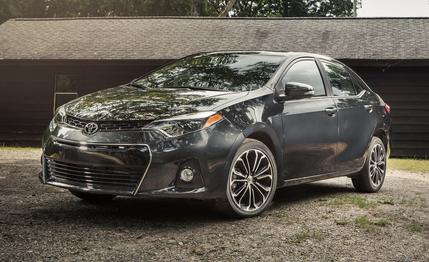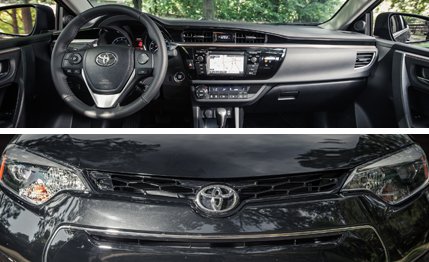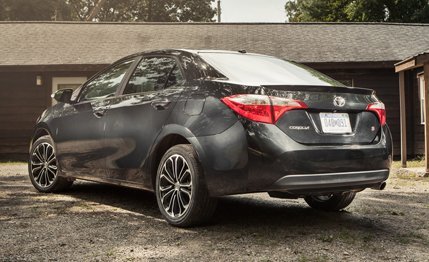
 Instrumented Test
TESTED
Instrumented Test
TESTED
Small and thrifty don’t always mean dull. After all, rides like the Ford Focus, Mazda 3, and Volkswagen Golf have delivered economy and entertainment in equal measure for years. But the Toyota Corolla has rarely if ever focused on delivering dynamic goodness, even in sportier trims like the S of this test car. Any accolades ladled onto the Corolla have generally involved appliance-like thrift and durability, not passionate roadgoing performance, and that seemingly stands for the 2014 redesign.
What’s “S” Got to Do with It?
At least the new Corolla is more visually exciting than those of the recent past, which goes extra for the S trim. In addition to the scarlet S badges affixed to their posteriors, 2014 S models get a prominent chrome-ringed, piano-black grille and a chrome exhaust tip and can be had with unique 17-inch wheels. (The integrated rear spoiler and fog lamps are shared with the Corolla LE.) Thankfully, the super-cheesy, pseudo-aero exterior extrusions glued to previous Corolla S models were left out of the product plan this time. Thus outfitted, the Corolla, for the first time in years, can be seen from 40 paces as something other than a bland four-wheeled transportation device for the indifferent.
Perhaps Toyota’s cheese connoisseur was reassigned to interior design, as the cabin has molded-in fake stitching on the steering wheel and dash and a mélange of variable-quality materials that never quite mesh visually. Still, the fit and finish is good. The three-spoke, leather-wrapped steering wheel and its shift paddles are sturdy enough, and the fabric-trimmed seats are comfortable, even if their sporty-looking bolsters are more of an affectation than serious driving equipment. Rear-seat legroom is up, too, as noted in our review of the 2014 Corolla LE Eco. S-trim Corollas trade the triple-dial instrument panel of lesser models for a proper two-dial tach-and-speedo setup bracketing a customizable TFT screen that displays the odometer and trip meters, outside temperature, current and average fuel economy, cruising range, average speed, elapsed time, and shift position, among other data.


The options list for the Corolla S Plus like ours is two items long: an $850 power sunroof and the $1510 Driver Convenience package. Ordering the latter requires the former, and ticking both boxes gets you must-have mod cons such as keyless entry, Entune premium audio with six speakers, USB and iPod connectivity, and a 6.1-inch high-resolution touch-screen display with navigation and satellite radio. Ours had it all and arrived at our office wearing a $22,870 bottom line.
In the Eighteens
The sportiest Corolla of the bunch relies on the same 132-hp, 1.8-liter four that powers most of its brethren. (The Corolla LE Eco packs eight more horsepower, thanks to a slightly higher compression ratio and revised valvetrain.) It’s available mated to a CVT or six-speed manual. Ours had the CVT. To minimize the elastic, Ski-Doo–like sensation typical of such transmissions, the S’s “shifts” at seven discrete points on the acceleration and deceleration curves, to kinda-sorta mimic actual gears. A Sport mode alters the theoretical shift points and holds each “gear” under braking. Manual shifting is achieved by the aforementioned wheel-mounted paddles or by the manual gate on the console shifter. We get that a CVT is a more compact, typically lighter alternative to a traditional automatic, but when you’re spending time programming “shift” points, why not just install a seven—or more—speed automatic? This CVT’s operation is literally seamless in non-S Corollas, but the package is out of sync with this model’s supposed intentions. We’d gladly trade the CVT’s extra 1 mpg on the highway for the driver involvement of the stick.
At the test track, our best run to 60 mph took 10.5 seconds—0.8 second behind the LE Eco and 0.2 behind even the Prius V—with the quarter-mile taking 18.1 seconds. The Sport mode affectation modifies the steering for a “more sporting” driving sensation—so, higher effort—but it always feels essentially numb from lock-to-lock, the howl of the 215/45 rubber a far more consistent and reliable indicator of how close the car is to its low limits. Although S models with the 17s have their own spring, damper, and bushing tuning, we only managed to match the 0.79 g of grip posted by the LE Eco on our 300-foot-diameter skidpad. The ride remains Corolla cushy, though, so the car has that going for it.


The Brakedown
Arguably, the most tangible S upgrade ought to be its adoption of rear disc brakes as standard over other Corollas’ drums. (Yes, hard as it might be to believe, most of the Corolla lineup still makes do with nine-inch rear drum brakes.) The presence of the 10.2-inch discs made a difference, all right—in the wrong way. Our best 70-to-0-mph stop in the S came in at 194 feet, a full 16 feet longer than the drum-brake-equipped Corolla LE Eco we tested on the same day. Even the 2009 Corolla XRS stopped in 175 feet. At least fade was minimal. This poor performance and the skidpad number suggest that the Firestone FR740 tires might not be the most suitable option for the S’s ambitions.
Ultimately, small and thrifty do mean dull as they concern the Corolla, although that’s not exactly a problem for its maker. The model continues to be a worldwide bestseller—some 40 million Corollas have found homes across all generations—and if even the “sporty” version doesn’t set enthusiasts’ hearts racing, well, Toyota is perfectly happy cashing checks from the vast populace who prefer their tickers to beat at a resting rate. As for us, we’ll continue to look elsewhere for cheap thrills.